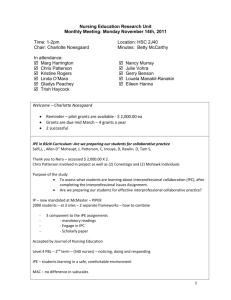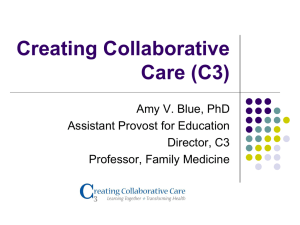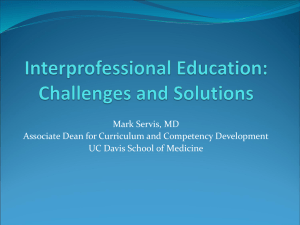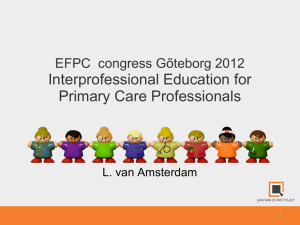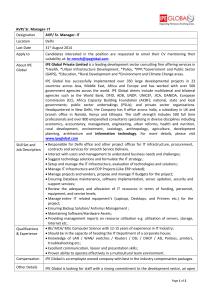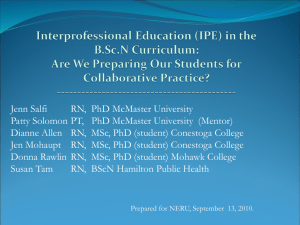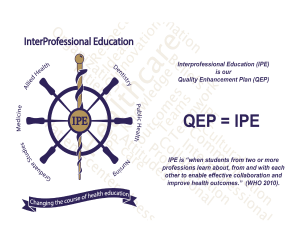Interprofessional Education & Teaching
advertisement
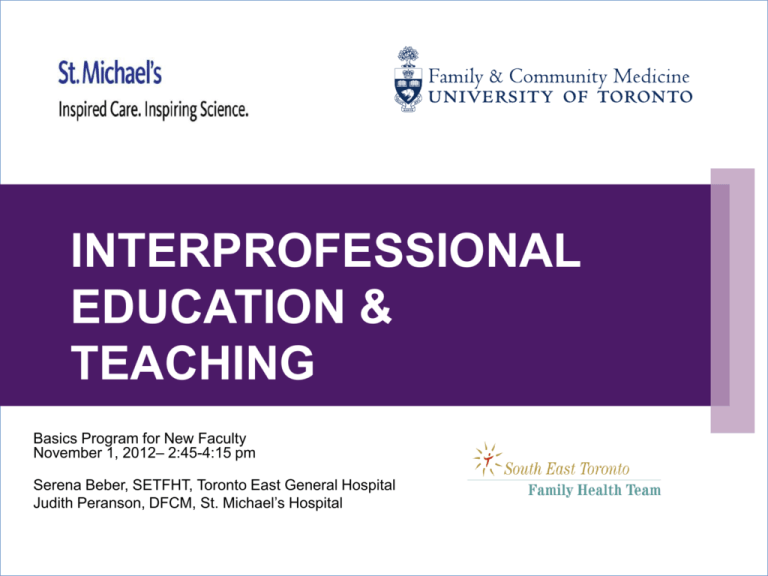
INTERPROFESSIONAL EDUCATION & TEACHING Basics Program for New Faculty November 1, 2012– 2:45-4:15 pm Serena Beber, SETFHT, Toronto East General Hospital Judith Peranson, DFCM, St. Michael’s Hospital INTRODUCTIONS • • • • Familiar with IPE concepts? Previous IPE experience? Feel confident teaching in IPE settings? Personal learning objectives? LEARNING OBJECTIVES 1. To review the rationale for IPE in health professional education. 2. To discuss key components of an IP learning experience. 3. To generate practical tips for common IPE settings, including small group and one-to-one clinical teaching. AGENDA 1. Introductions 2. Why are we doing this? 3. IPE Basics • Key features 4. Tips for IP Teaching • • • Challenges unique to IPE Small group learning One-to-one clinical teaching 5. Taking IPE home VIDEO 1 - REFERRAL The videos used in this workshop can be purchased from the University of Toronto’s Centre for Interprofessional Education at ipe.utoronto.ca. Find the order form here: http://ipe.utoronto.ca/resources/dvd-tools. For University of Toronto faculty, staff and students with UTOR IDs, the Library has now made the series available via streaming, click to access here. VIDEO 1: REFERRAL • What is happening in the scenario? Who is involved? • Is this a teachable moment? If so, what issues around roles or collaboration could be discussed? • What are some alternative options for handling this scenario? A NEW VISION FOR HEALTH CARE IN CANADA “If health care providers are expected to work together and share expertise in a team environment, it makes sense that their education and training should prepare them for this type of working arrangement.” Romanow, 2002 INTERPROFESSIONAL CARE •Interprofessional Collaboration (IPC) is the provision of: • Comprehensive health services to patients • By multiple health care providers who • Work collaboratively to deliver quality care • Within and across settings Interprofessional Care: A Blueprint for Action in Ontario, July 2007 EVIDENCE FOR IPC Growing evidence that IPC leads to: • Increased access to health care • Improved outcomes in chronic illness • Less tension and conflict among providers • Better use of clinical resources • Easier recruitment and less turnover of staff Interprofessional Care: A Blueprint for Action in Ontario, 2007 It shouldn’t be so complicated… so why is it? Socialization – Identity and Autonomy System / Institutional Barriers Real-world Professional Practice – – – – Different “cognitive maps” “Role blurring” – overlapping competencies Gender and power issues Regulatory and liability issues Patient Expectations INTERPROFESSIONAL EDUCATION Interprofessional education occurs when (learners) from two or more professions learn about, from, and with each other to enable effective collaboration and improve health outcomes. Professional is an all-encompassing term that includes individuals with the knowledge and/or skills to contribute to the physical, mental and social well-being of a community WHO, 2010 VIDEO 2 – Ulcer Management The videos used in this workshop can be purchased from the University of Toronto’s Centre for Interprofessional Education at ipe.utoronto.ca. Find the order form here: http://ipe.utoronto.ca/resources/dvd-tools. For University of Toronto faculty, staff and students with UTOR IDs, the Library has now made the series available via streaming, click to access here. VIDEO 2: ULCER MANAGEMENT • What key features of IP learning are demonstrated in this scenario? • How did the facilitator demonstrate effective facilitation? • If the group did not progress as quickly as in this instance, how else might the facilitator have intervened? INTERPROFESSIONAL EDUCATION ≠ MULTIPROFESSIONAL EDUCATION What is the key element in IPE? INTER-ACTION INTERPROFESSIONAL EDUCATION Requires background knowledge of one’s own role and scope of practice Involves interactive learning with different professional groups Educational goals: Knowledge of and appreciation for other professional perspectives and skills Skills in being an effective team player IP LEARNING REQUIREMENTS RESIDENCY CanMEDS-FM Competencies Collaborator Communicator Professional Manager Triple C Competency-Based Curriculum – Comprehensive Care and Education – Continuity of Education and Patient Care – Centered in Family Medicine CFPC Report of the Working Group on Postgraduate Curriculum Review – Part 1 (March 2011) COMMON CHALLENGES IN IPE When to introduce? Appropriate mix of learners? Time and space issues? Faculty development? Physician engagement? VIDEO 3 - SHOTS The videos used in this workshop can be purchased from the University of Toronto’s Centre for Interprofessional Education at ipe.utoronto.ca. Find the order form here: http://ipe.utoronto.ca/resources/dvd-tools. For University of Toronto faculty, staff and students with UTOR IDs, the Library has now made the series available via streaming, click to access here. VIDEO 3: SHOTS What challenges to IP learning are illustrated in this scenario? What attempts were made to enhance IP learning? How could this learning opportunity be improved? INTERPROFESSIONAL LEARNING IN CLINIC The same as adult education principles, with emphasis on specific areas •Small Group Learning •Situational Learning TIPS FOR SMALL GROUP TEACHING 1. Plan ahead. 2. Convene the group and develop a mutually acceptable agenda. 3. Create a positive atmosphere. 4. Focus the group on the task at hand. 5. Promote individual involvement and active participation. 6. Vary the teaching methods. Steinert, 1996 TIPS FOR SMALL GROUP TEACHING 7. Provide relevant information and respond appropriately. 8. Observe & clarify group process. 9. Work to overcome commonly encountered problems. 10.Synthesize and summarize the group discussion. 11.Evaluate the session and plan for follow up. 12.Enjoy yourself and have fun! Steinert, 1996 IPE IN PRIMARY CARE ONE-TO-ONE CLINICAL TEACHING Informal or unscheduled IPE Cross-discipline teaching and collaboration Model collaborative care, enthusiasm for teaching and clinical competence Is the patient present? SUMMARY 1.Why are we doing this? – Video 1 - referrals Taking – Video 2 – ulcer management IPE – Key features 3.Tips for IP Teaching Home... – Video 3 – shots 2.IPE Basics – Challenges unique to IPE – Small group learning – One-to-one clinical teaching TAKING IPE HOME What could YOU incorporate into your current teaching setting to enhance collaborative learning • For learners from your own discipline? • For a learner from a different profession? THANKS! Questions? Comments? Serena Beber serena.beber@utoronto.ca Judith Peranson judith.peranson@utoronto.ca RESOURCES & REFERENCES • UofT Centre for IPE: http://ipe.utoronto.ca/ • Canadian Interprofessional Health Collaborative (CIHC) • http://www.cihc.ca/ • Oandasan, I., & Reeves, S. (2005). Key elements for interprofessional education. part 1: The learner, the educator, and the learning context. Journal of Interprofessional Care, 19(suppl 1), 21-38. • Oandasan, I., & Reeves, S. (2005). Key elements for interprofessional education. Part 2: Factors, processes, and outcomes. Journal of Interprofessional Care, 19(suppl 1), 39-48. • Steinert, Y. (1996). Twelve tips for effective small-group teaching in the health professions, Medical Teacher, 18, 99203-207.
